Whether it’s for rainwater or sprinkler runoff, having adequate drainage is important for the health and safety of your home. A drain pipe helps to drain excess water near a building’s foundation, but it needs to be installed correctly to ensure that it does its job efficiently.
To properly install a drainage pipe, dig a trench in the soil beneath your property. Line it with landscaping fabric, add gravel to the bottom, and then lay the pipe in the trench.
Trench
A trench is a long, narrow pit that is dug into the ground to install pipes or other drainage elements. It is also a way to keep gas, electric and phone lines underground, which helps to reduce clutter aboveground and minimizes the risk of them being damaged by natural disasters.
Trenches can be sunk in different ways, depending on the purpose and size of the drain needed. Typically, they are used for installing drains to direct surface water away from areas that need to be dry.
Whether the trench is for drain pipe installation or other purposes, you will want to create a plan for where you are going to dig. You will also need to decide on the sloping of the area.
You will need to create a slope of at least one inch for every 10 feet of the length of the trench, as this will help to redirect excess water away from your property. This is important because if the water is not drained properly, it can cause flooding in your yard and damage your garden.
Pipe
Drain pipes carry wastewater from your home’s plumbing fixtures to the municipal sewer or septic field. They typically run horizontally under the lowest floor of your house.
The most common residential piping is made of PVC (polyvinyl chloride) or ABS plastic. These pipe types are cheap, easy to transport and fit together tightly.
They’re also durable and resistant to a wide range of chemicals. But they do come with some drawbacks, like the risk of tree roots getting into the joints. And they can warp and deform under certain conditions.
Fittings
There are a variety of fittings used for drain pipe installation. These include tee and wye connections, couplers, elbows, and caps.
A tee has one inlet and two outlets at 90-degree angles in the shape of a “T.” It splits a supply line or combines two lines into one outlet. A wye is similar, but the inlets come together at 45 degrees into a single outlet for drain applications.
Tee and wye fittings are often made of stainless steel or chromium alloy. These pipes are more durable than copper or PVC, and can handle higher pressures.
Cast iron was once a common pipe material for drainage systems, but today it’s mostly replaced with plastic. These pipes are more affordable and easier to work with.
There are a variety of fittings available, including tees and wyes, elbows, cap, and reducers. The type of fitting you use depends on what you’re trying to do with the piping.
Installation
Drain pipes are used to transport wastewater from latrines, bathrooms, sinks and washbasins from the home or building into the municipal sewer system. They are also used to convey surface water, such as rainwater and sprinkler runoff, from outside of your property into your basement or other low-lying area.
To properly perform a drain pipe installation Fort Worth, you need to plan a route that will allow the water to flow downhill away from any structures on your property. This requires digging a trench that is at least two feet wide and six feet deep, and removing buried power lines, gas lines and other underground utilities.
To start, mark the area where you plan to dig your French drain. Then call 811 to have a call center agent flag underground lines that may affect your project. This will ensure that your new drainage solution is in compliance with city codes and won’t harm neighboring properties.
Before beginning the excavation process, be sure to consult with any local homeowners, building or zoning authorities. Some areas have regulations that prohibit the installation of French drains.



